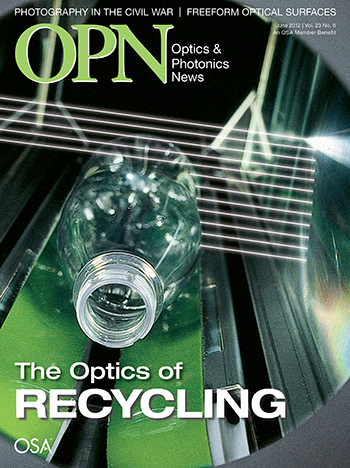
June 2012 Issue
Feature Articles
Optical technologies, including laser scanning and spectroscopy, can be used to identify and sort recyclable materials in a way that makes efficient use of available natural resources and helps to reduce fossil fuel consumption—all in a cost-effective manner.
by Andreas NordbryhnPhotography in the American Civil War
One hundred and fifty years ago, a rapidly evolving imaging technology came to a divided nation where citizens were fighting each other on bloody battlefields. The rest, as they say, is history.
by Patricia DaukantasFreeform Optical Surfaces: A Revolution in Imaging Optical Design
A revolutionary optical surface is the result of developments in the theory of aberrations, techniques in optical system optimization, computation speed, precision fabrication of surfaces without symmetry, and extensions to the range of the surface slopes allowed in optical testing.
by Kevin P. Thompson and Jannick P. RollandDepartments and Columns
Laser Fabricates Silver Dots in a Polymer Matrix
A team at Harvard University (U.S.A.) has developed a fabrication process that enables the creation of nanostructures patterned in 3-D.
Better Super-Capacitors from Laser-Scribed Graphene
Researchers from the University of California, Los Angeles (U.S.A.) used a common computer optical drive to convert thin layers of graphite oxide into graphene, which was then incorporated into flexible electrochemical capacitors.
Mode-Locking Method Shows Stable Output, Potential for Tiny Lasers
An international team of researchers used a microcavity ring resonator as both a laser filter and mode-locker.
How to Build a Thriving Undergrad Physics Program
Undergraduate physics programs introduce students to the wonderful world of optics. This case study from California provides insight into how to strengthen your department and improve recruitment strategies.
Quantum and Nano-optics in Spain: A Success Story
Quantum and nano-optics institutes such as ICFO and CIC nanoGune are helping to bridge the gap between theoretical research and industry in Spain. Recent increases in funding and research will no doubt attract thought leaders worldwide and accelerate development of photonics-based technologies.
Self-Assembling Microlenses Inspired by Starfish
Scientists in Germany recently made good-quality calcium carbonate microlenses by precipitating them out of solution. They got inspiration a reef-dwelling brittlestar whose body is covered with tiny calcium carbonate lenses that act as the lenses for compound eyes.
Transparent Metals: Fact and Fiction
Transparent metals are a common theme in many science fiction plots—an alien compound that is incredibly strong, yet see-through. However, this material is not as futuristic as it sounds. Methods for producing transparent metals have been around for centuries and are now being used for high-performance military applications.
Presidential Profile: Frederick Dowswell Smith
F. Dow Smith, an American physicist by way of Canada, made a name for himself as one of the lead developers of spy satellite technology during the height of the Cold War between the United States and the Soviet Union.
Also in this Issue
OSA proudly announces the recipients of its 2012 awards and medals. The society has chosen to honor these distinguished individuals because they have exhibited dedication, ingenuity and perseverance in attaining the highest level of achievement in their chosen fields. The OSA Board of Directors approved the awards at its meeting in February. Most of these awards will be presented at Frontiers in Optics, the 96th OSA Annual Meeting, in Rochester, N.Y., U.S.A., in October 2012.


![Manual probe system with needles for test of semiconductor on silicon wafer. [A. Morozov / Getty]](https://opnmedia.blob.core.windows.net/$web/opn/media/images/articles/2025/1125/departments/202511-cover-web.jpg?ext=.jpg)
![Researcher Clara Saraceno in the lab. [Image by Carsten Behler Photography]](https://opnmedia.blob.core.windows.net/$web/opn/media/images/articles/2025/1025/departments/202510-cover-web.jpg?ext=.jpg)
